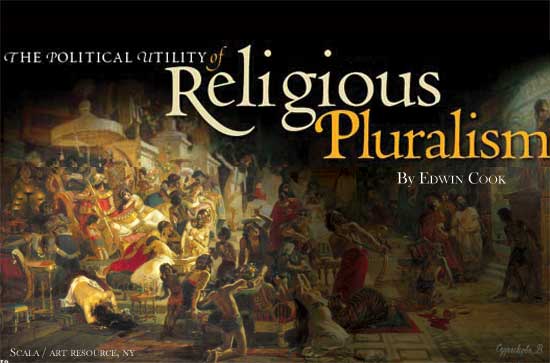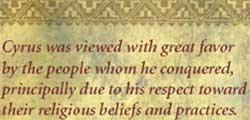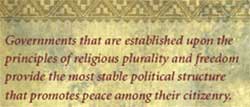The Political Utility of Religious Pluralism
Edwin C. Cook November/December 2006
Getting your Trinity Audio player ready...

On the eve of October 12, 539 B.C. (Tishri 16), the inhabitants of Babylon rested in ease and security. It was a grand city not far down the river Euphrates from the site of present-day Baghdad. In the festal hall of King Nabonidus' summer palace, his son, Belshazzar, who had been appointed as prince regent, passed the early hours of the night with gaiety, laughter, and mirth.1 Although under siege by the Medo-Persian forces, Babylon's inhabitants trusted in the impregnable series of walls that surrounded the city.2
Amid the nightlong festivities, however, other individuals, discontented with King Nabonidus' religious policies, were conspiring his overthrow. On learning of the coalition of Median and Persian forces, King Nabonidus commanded that all idols of local deities be brought from throughout the empire and placed in Babylon. By so doing, he hoped to secure the blessings of the gods and to ensure their intervention for the overthrow of the Medo-Persian forces. However, he did not find ready allies in the priests at Babylon, who felt he had acted with impunity regarding local cultic practices. In addition, they felt he was introducing heretical practices by elevating the moon god, Sin, above the traditional Babylonian deity, Marduk. By disregarding his subjects' wishes, especially those of their religious leaders, Nabonidus aroused their discontent and paved the way for the precipitous fall of Babylon that night to Medo-Persian forces. As the book of Daniel in the Bible says, "That very night Balshazzar, king of the Chaldeans, was slain. And Darius the Mede received the kingdom" (Daniel 5: 30, 31, NKJV).
Against this historical backdrop, the Persian ruler Cyrus drew favor among conquered peoples by his practice of allowing religious pluralism to thrive within the empire. But who was this Cyrus, the Persian king who was instrumental in the fall of Babylon? What political and religious policies did he espouse and advocate that contributed to his success as a ruler? To fully appreciate his then-novel concepts, it helps to take a brief historical review of Cyrus and the Medo-Persian Empire he ruled.
The Origins of Cyrus, the Shepherd of the Lord
The Holy Bible says that the Lord God designated Cyrus as His appointed agent to release His people from Babylonian captivity and to restore the Jewish temple at Jerusalem. He declared through the prophet Isaiah, "That saith of Cyrus, He is my shepherd, and shall perform all my pleasure: even saying to Jerusalem, Thou shalt be built, and to the temple, Thy foundations shall be laid."3 H.W. F. Saggs provides a brief historical account of the beginning of the Persian tribes from which Cyrus came: "The Persians were originally one of the migratory Indo-Aryan tribes, who had ultimately settled in Elam. Their royal family was founded in the middle of the seventh century, after Ashurbanipal had knocked out the old Elamite dynasty, by Achaemenes (Hahmanish), whose son took the title of 'King of Anshan': Anshan was originally one of the princedoms of the kingdom of Elam, and the new title connoted kingship over that ancient land. The rising power of the kingdom of Persia led the Median king Astyages to give a daughter in marriage to Cambyses I, the third king of Anshan, and from this marriage Cyrus was born."4
The Rule of Cyrus
Once Cyrus had overthrown the Median ruler Astyages, he was able to unite the Median and Persian peoples through tactful diplomatic policies that were noted for religious toleration.5 Ironically, it was the united efforts of Nabonidus and Cyrus in 553 B.C. that defeated the Medes.6 Cyrus rapidly became a powerful force among the peoples of Mesopotamia.7 After defeating three principal armies, he marched to Babylon and easily conquered it.8

Even more significant was the fact that Cyrus not only granted religious toleration, but he "protected and encouraged religious diversity."16 He even went as far as to pay from the state treasury for the rebuilding of temples and the restoration of religious services.17
In addition to his policy of religious toleration, Cyrus was noted for qualities of cooperation and accommodation in his diplomatic decisions, even those that were nonreligious.18 For such reasons, the Persian government was referred to as "tolerant." Another innovation of Cyrus's government was to adopt the religious customs and practices of the people whom he had conquered. For example, in Babylon, Cyrus proclaimed himself king as the chosen of Marduk.19 Moreover, Cyrus even allowed this policy of toleration to guide in his treatment of the deposed rulers that he conquered, such as sparing the life of Nabonidus at the fall of Babylon.20
Of significant note to religion-state relations, no mention is made "of terrorizing massacres, enslavement, or relocation of the population of the conquered territories; nor do we encounter any cases of religious persecution."21 Masroori argues that Cyrus's religious policy22 was an attempt "to rule by propaganda," rather than by terror as the Assyrian kings had done, and that it was "a calculated design based on political goals." Thus, Paul-Alain Beaulieu correctly states: "The policy of religious toleration employed by Cyrus may correctly be identified as a political tool that he used to facilitate the unification of a diverse body of people located within the boundaries of his empire."23
From the perspective of religion-state relations, Cyrus Masroori makes the most significant statement regarding the reign of King Cyrus: "With regard to Lydia, it has been suggested that indeed Cyrus may have established some contact with the priests of the temples of Apollo in Miletus and Delphi, and obtained their support for his rule over the Greek city-states of Asia Minor. There is also some evidence that Cyrus capitalized on religious conflicts in Babylon, united himself with the priests of Marduk, and with their support, conquered the city. In addition, it has been argued that prior to his invasion of the city, Cyrus had sent some of his agents to the Jewish community of Babylon to acquire their support."24 Thus, this information helps to clearly establish the political motivation that prompted Cyrus to utilize religious practices and theological beliefs to achieve his ambitious goals.
The Rule of Cambyses
Cambyses II was the son and successor of Cyrus. In general, his reign can be described as that of his father. He sought the favor of the Egyptians by sacrificing to their gods and even taking an Egyptian title as their king. He granted authority to the Egyptian priest Uzahor to restore the temple revenues and thus sanctioned their native religion.25
Later in his reign, he demonstrated a policy of intolerance and even destruction of Egyptian temples.26 Gray offers this explanation for such rare action by Cyrus's son: "Herodotus attributes this later conduct to a mental breakdown of Cambyses, and some, accepting this, have traced the madness to the hardships and ill-successes of the Ethiopian campaign. Possibly it was due to political plots in which priests and officials of the temples were conspicuously involved."27
After Cambyses' death, an impostor, claiming to have been the brother of Cambyses, reigned for a few months. During his short reign, he destroyed several temples, which were later restored. He was later killed by Darius, who became the next Medo-Persian ruler.28 One of the first acts that Darius I ordered to be done was the restoration of these temples.29
Darius's reign is slightly different from that of Cyrus and Cambyses. While he continued the policy of religious toleration initiated by Cyrus, he was barbaric in dealing with kings of those countries that revolted against Medo-Persian rule.30 As Cyrus had done, Darius also engaged in the rebuilding of temples. He also provided for the cost of sacrifices offered daily for the lifetime of the king and his sons.
Tolerance and Plurality
From a political perspective, the religious policy initiated by Cyrus was, with the exception of Esarhaddon's example,31 an innovative method of securing the support of conquered lands and of uniting them together. This policy of toleration that he initiated was generally followed by his successors.
From a religious perspective, Cyrus introduced the novel concept of religious tolerance and plurality32 among societies and nations where religious intolerance was an accepted norm. Although motivated by political reasons, these concepts formed the guiding principles that marked the Medo-Persian Empire in its relation to the nations it conquered. Through such far-sighted wisdom, Cyrus achieved political unity of diverse people groups that established his empire upon enduring foundations. By recognizing and respecting an area cherished by most groups of people—their religious beliefs—Cyrus demonstrated a political approach characterized by historians as unique and innovative.

Second, since the Lord designated Cyrus as "My shepherd," and since history records Cyrus as practicing religious toleration and fostering religious plurality, this seems to indicate how the Lord regards such practices. In religious matters, He does not coerce the consciences of subjects through their rulers, nor of citizens through their duly elected civic representatives. This view is reiterated in the New Testament in Romans 13:1-8, where the apostle Paul admonishes Christians to be subject to "the powers that be" because the civil rulers have been ordained by God to maintain order in society, without involving themselves in the religious sphere of their subjects.33
Third, based on Cyrus's policy of accommodating the religious beliefs of each people group he conquered by promoting their religious practices, the question is raised: To what extent should government be involved in religion? Some of Cyrus's actions of using state/government funds to promote various religious groups through building and restoring temples seem to parallel the arguments of those advocating "positive neutrality" (also known as "equal treatment," or government support of all religions) in American society today. What validation, if any, is there in this approach to religion-state relations? From the historical record, it becomes evident that Cyrus used "equal treatment" strictly as a political tool to further his own ambitious ends. Taking into consideration that the Medo-Persian Empire had no constitutional guidelines forbidding such practices, this policy served to bring political cohesion to his empire. The conclusion one seems to draw on this point is that the Lord allowed this policy of government support of religion ("equal treatment") solely for the sake of reestablishing His people, the Jewish nation, in their homeland, but He does not advocate this policy as His preferred method since New Testament teachings do not validate government support of a Judeo-Christian body politic. Thus, we must enquire into the motivation of political or religious groups advocating "equal treatment" today in American society. Since Cyrus used this method strictly for political reasons, do those who advocate its use today probably have the same political motivations?
In summary, since the Lord endorsed Cyrus as His shepherd, the biblical and historical record indicates:
1. The Lord is not limited to a Judeo-Christian political structure to accomplish His purposes on earth. He works through secular and heathen governments to achieve His sovereign will among earth's inhabitants.
2. The Lord is well-pleased and supportive of those governments that allow for freedom from religious persecution, even if they don't acknowledge Him.
3. Those governments granting religious freedom should not misconstrue the Lord's endorsement of Cyrus as His intention that government should proactively aid and support religion. Both the biblical and historical record indicate that the Lord designated Cyrus as His shepherd for the sake of freeing Israel from Babylonian captivity, of allowing them to reestablish the city of Jerusalem, and of aiding them in rebuilding the temple. Cyrus did this for the Israelites, as well as for numerous other religious groups, strictly for political reasons. To misinterpret his actions as endorsement of religion as such is to err from the historical and biblical record.
4. Those governments that are established upon the principles of religious plurality and freedom provide the most stable political structure that promotes peace among their citizenry.
Edwin Cook is currently pursuing a degree in church-state studies at Baylor University, Waco, Texas.
1 The book of Daniel, chapter 5, in the Holy Bible.
2 Herodotus claimed the walls were 56 miles long, 80 feet thick, and 320 feet high. Modern excavations, however, have shown the exaggeration of such claims, indicating a more accurate figure of walls that were 10 miles in length. The outer wall consisted of three separate walls, the first and second of which were about 22 feet thick and the third of which was about 10 feet thick. Although less extensive than Herodotus' claim, these proportions were nonetheless formidable and impregnable for military equipment of that day.
3 Isaiah 44:28.
4 H.W.F. Saggs, The Greatness That Was Babylon (New York: The New American Library, 1962), pp. 151, 152.
5 Morris Jastrow, Jr., The Civilization of Babylonia and Assyria (Philadelphia: J. B. Lippincott Company, 1915), pp.184, 185; Saggs, p. 156.
6 Saggs, p.153.
7 George Stephen Goodspeed, A History of the Babylonians and Assyrians (New York: Charles Scribner's Sons, 1920), pp. 369, 373.
8 Saggs, p.152.
9 Ronald H. Sack, "Nabonidus of Babylon," in Crossing Boundaries and Linking Horizons: Studies in Honor of Michael C. Astour on His 80th Birthday, eds. Gordon D. Young, Mark W. Chavalas, Richard E. Averbeck (Bethesda, Md.: CDL Press, 1997), p. 461; Saggs, p. 152.
10 Sack, p. 470.
11 A cuneiform document describes the statue of the moon god, Sin, that Nabonidus set up in the temple at Babylon as "an heretical image"(Babylonian Historical Texts, by Sidney Smith [1924]: p. 87, quoted by Saggs, p. 156).
12 Jastrow, p. 220.
13 Cyrus Cylinder, p.11ff, quoted in Goodspeed, p.375; Sack, p. 466.
14 Saggs, p. 155; G. Buchanan Gray, "The Foundation and Extension of the Persian Empire," in The Cambridge Ancient History, Volume 4: The Persian Empire and the West (Cambridge: Cambridge University Press, 1960), p. 12.
15 Paul-Alain Beaulieu, "An Episode in the Fall of Babylon to the Persians," Journal of Near Eastern Studies 52 no. 4 (October 1993): p. 242; Gray, p. 13; Cyrus Masroori, "Cyrus II and the Political Utility of Religious Toleration," in Religious Toleration: "'The 'Variety of Rrites' From Cyrus to Defoe, ed. John Christian Laursen (New York: St. Martin's Press, 1999), p. 17.
16 Masroori, p. 15.
17 Gray, p. 187.
18 Masroori (pp. 18-20) cites numerous examples from sources such as Persian Wars and Cyropaedia, of how Cyrus demonstrated toleration in all diplomatic relations, whether religious or nonreligious.
19 Gray, pp. 186, 187.
20 Ibid, p. 187.
21 Masroori, p. 24.
22 Ibid., pp. 26-28.
23 Beaulieu, p. 243.
24 Masroori, pp. 30, 31.
25 Gray, pp. 22, 23.
26 Ibid., p. 22. These facts are attested by records from among a neutral group, the Jews of Elephantine.
27 Ibid., p. 23.
28 Masroori, p. 21.
29 Ibid., p. 24.
30 G. B. Gray and M. Cary, "The Reign of Darius," in The Cambridge Ancient History, Volume 4: The Persian Empire and the West (Cambridge: Cambridge University Press, 1960), p. 187.
31 Barbara Nevling Porter, "God's Statues as a Tool of Assyrian Political Policy: Esarhaddon's Return of Marduk to Babylon," in Religious Transformations and Socio-political Change: Eastern Europe and Latin America, ed. Luther Martin (New York: Mouton de Gruyter, 1993), passim.
32 Perhaps the best analysis of Cyrus's contributions to religion-state relations is that offered by Cyrus Masroori: (1) "First, the Assyrians, Babylonians, and Medians in general relied on a policy of terror to rule their subjects, setting a high cost for disobedience. In contrast, Cyrus relied on peaceful policies such as religious accommodation, obtaining his subjects' support largely through providing incentives for their loyalty. (2) Although some ancient religions in the Middle East did not include dogmatic beliefs toward other religions, this did not mean that religious toleration was typically exercised in those ancient societies. (3) In addition, Cyrus's toleration policy was much more comprehensive than Esarhaddon's. To appreciate this point, one must remember that at the end of his reign, Cyrus's empire was composed of a variety of religions, none of which was persecuted" (Masroori, pp. 23, 24).
33 For a detailed historical analysis of Romans 13:1-8, please see the article "Parousia or Politics?" in the January-February 2005 issue of Liberty.
Article Author: Edwin C. Cook
Edwin Cook has a doctorate in church-state studies from Baylor University, Waco, Texas. He writes from Waco.